Business Administration Essay: Leadership Styles of Successful Leaders
VerifiedAdded on 2020/04/15
|8
|2127
|137
Essay
AI Summary
This essay critically analyzes the leadership styles of three prominent business leaders: Warren Buffet, Jeff Bezos, and Larry Page, focusing on transformational, transactional, and democratic leadership approaches. The essay begins by defining leadership and its importance in achieving organizational goals, highlighting the contingency theory and the need for adaptability. It then delves into the leadership styles of each leader. Jeff Bezos is examined for his transactional and transformational leadership in building Amazon's success, emphasizing task-oriented leadership, innovation, and a demanding work environment. Warren Buffet is analyzed for his democratic and laissez-faire leadership style, focusing on employee empowerment, engagement, and trust, as demonstrated through Berkshire Hathaway's performance. Finally, Larry Page's transformational leadership at Google is discussed, with an emphasis on fostering innovation, creativity, and collaboration through initiatives like the 70-20-10 policy and transactional elements to maintain order. The essay concludes by emphasizing the importance of adaptability in leadership and the impact of leadership styles on employee performance and organizational culture, with references to relevant literature.
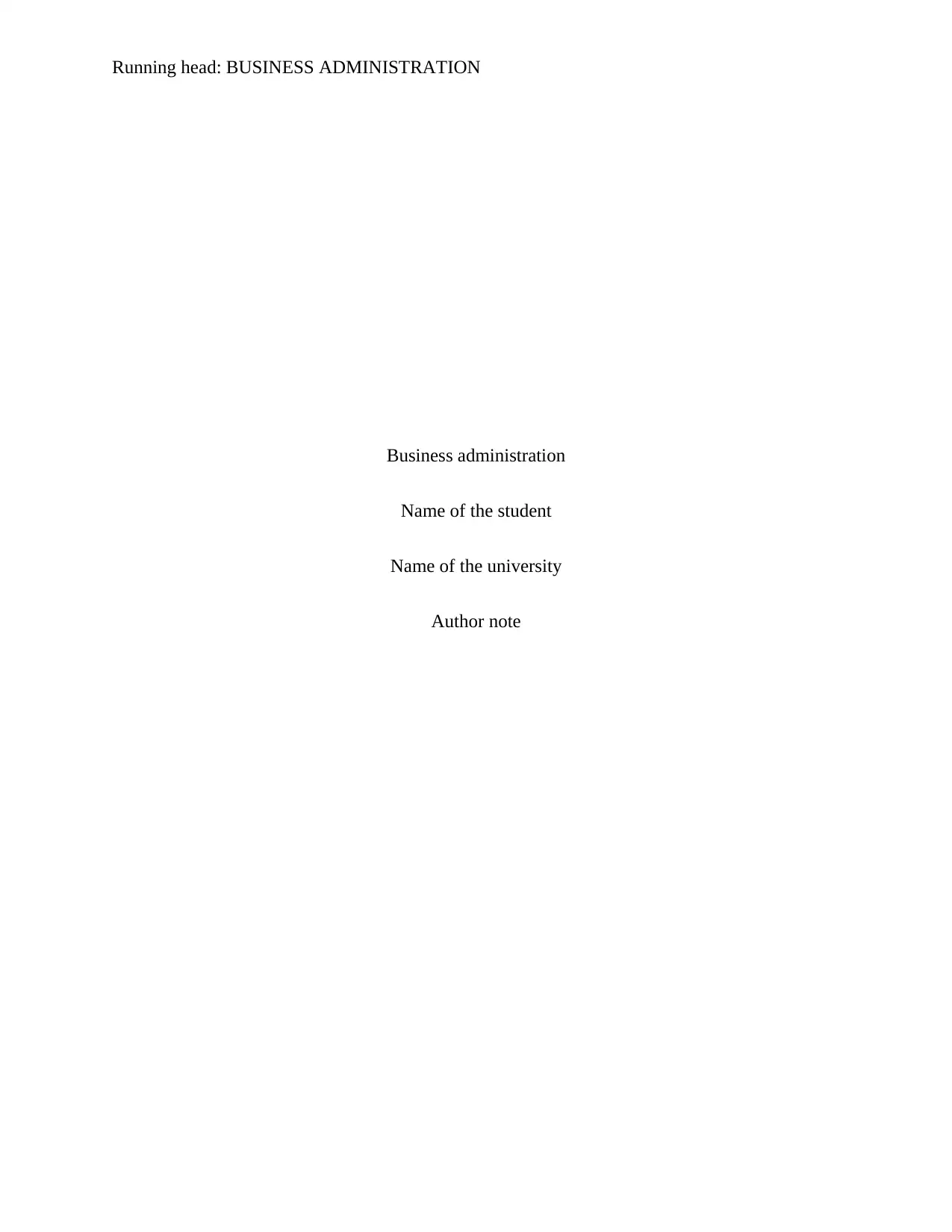
Running head: BUSINESS ADMINISTRATION
Business administration
Name of the student
Name of the university
Author note
Business administration
Name of the student
Name of the university
Author note
Paraphrase This Document
Need a fresh take? Get an instant paraphrase of this document with our AI Paraphraser
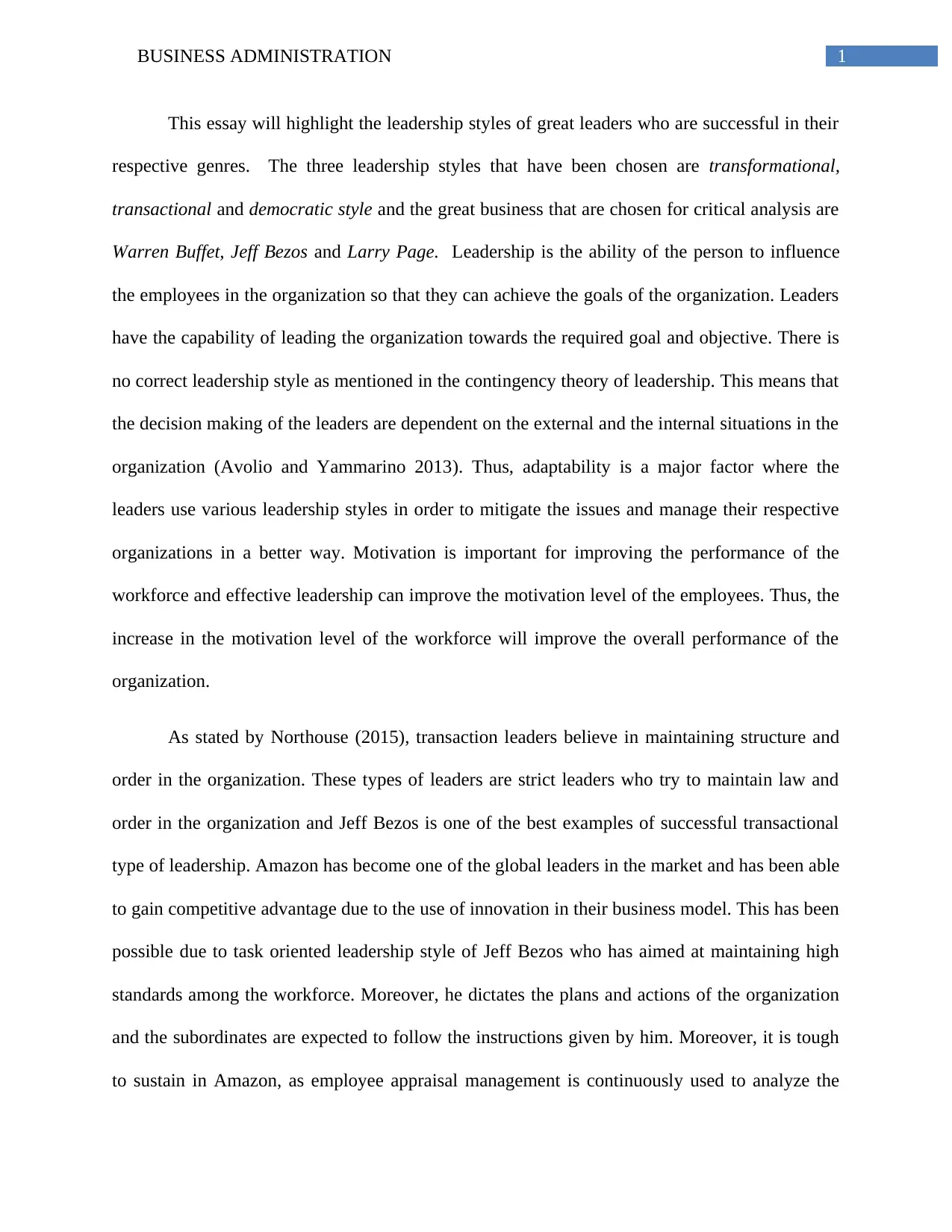
1BUSINESS ADMINISTRATION
This essay will highlight the leadership styles of great leaders who are successful in their
respective genres. The three leadership styles that have been chosen are transformational,
transactional and democratic style and the great business that are chosen for critical analysis are
Warren Buffet, Jeff Bezos and Larry Page. Leadership is the ability of the person to influence
the employees in the organization so that they can achieve the goals of the organization. Leaders
have the capability of leading the organization towards the required goal and objective. There is
no correct leadership style as mentioned in the contingency theory of leadership. This means that
the decision making of the leaders are dependent on the external and the internal situations in the
organization (Avolio and Yammarino 2013). Thus, adaptability is a major factor where the
leaders use various leadership styles in order to mitigate the issues and manage their respective
organizations in a better way. Motivation is important for improving the performance of the
workforce and effective leadership can improve the motivation level of the employees. Thus, the
increase in the motivation level of the workforce will improve the overall performance of the
organization.
As stated by Northouse (2015), transaction leaders believe in maintaining structure and
order in the organization. These types of leaders are strict leaders who try to maintain law and
order in the organization and Jeff Bezos is one of the best examples of successful transactional
type of leadership. Amazon has become one of the global leaders in the market and has been able
to gain competitive advantage due to the use of innovation in their business model. This has been
possible due to task oriented leadership style of Jeff Bezos who has aimed at maintaining high
standards among the workforce. Moreover, he dictates the plans and actions of the organization
and the subordinates are expected to follow the instructions given by him. Moreover, it is tough
to sustain in Amazon, as employee appraisal management is continuously used to analyze the
This essay will highlight the leadership styles of great leaders who are successful in their
respective genres. The three leadership styles that have been chosen are transformational,
transactional and democratic style and the great business that are chosen for critical analysis are
Warren Buffet, Jeff Bezos and Larry Page. Leadership is the ability of the person to influence
the employees in the organization so that they can achieve the goals of the organization. Leaders
have the capability of leading the organization towards the required goal and objective. There is
no correct leadership style as mentioned in the contingency theory of leadership. This means that
the decision making of the leaders are dependent on the external and the internal situations in the
organization (Avolio and Yammarino 2013). Thus, adaptability is a major factor where the
leaders use various leadership styles in order to mitigate the issues and manage their respective
organizations in a better way. Motivation is important for improving the performance of the
workforce and effective leadership can improve the motivation level of the employees. Thus, the
increase in the motivation level of the workforce will improve the overall performance of the
organization.
As stated by Northouse (2015), transaction leaders believe in maintaining structure and
order in the organization. These types of leaders are strict leaders who try to maintain law and
order in the organization and Jeff Bezos is one of the best examples of successful transactional
type of leadership. Amazon has become one of the global leaders in the market and has been able
to gain competitive advantage due to the use of innovation in their business model. This has been
possible due to task oriented leadership style of Jeff Bezos who has aimed at maintaining high
standards among the workforce. Moreover, he dictates the plans and actions of the organization
and the subordinates are expected to follow the instructions given by him. Moreover, it is tough
to sustain in Amazon, as employee appraisal management is continuously used to analyze the
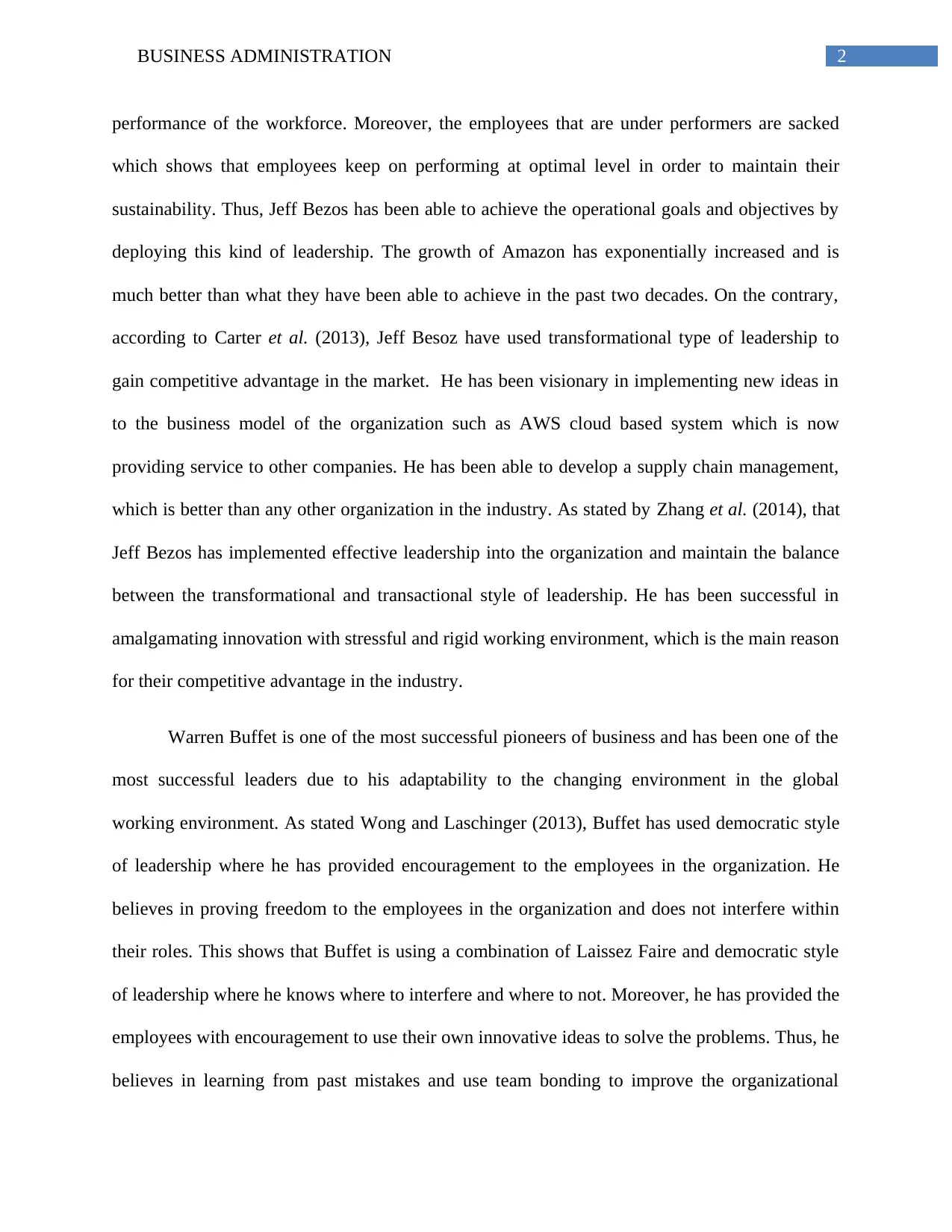
2BUSINESS ADMINISTRATION
performance of the workforce. Moreover, the employees that are under performers are sacked
which shows that employees keep on performing at optimal level in order to maintain their
sustainability. Thus, Jeff Bezos has been able to achieve the operational goals and objectives by
deploying this kind of leadership. The growth of Amazon has exponentially increased and is
much better than what they have been able to achieve in the past two decades. On the contrary,
according to Carter et al. (2013), Jeff Besoz have used transformational type of leadership to
gain competitive advantage in the market. He has been visionary in implementing new ideas in
to the business model of the organization such as AWS cloud based system which is now
providing service to other companies. He has been able to develop a supply chain management,
which is better than any other organization in the industry. As stated by Zhang et al. (2014), that
Jeff Bezos has implemented effective leadership into the organization and maintain the balance
between the transformational and transactional style of leadership. He has been successful in
amalgamating innovation with stressful and rigid working environment, which is the main reason
for their competitive advantage in the industry.
Warren Buffet is one of the most successful pioneers of business and has been one of the
most successful leaders due to his adaptability to the changing environment in the global
working environment. As stated Wong and Laschinger (2013), Buffet has used democratic style
of leadership where he has provided encouragement to the employees in the organization. He
believes in proving freedom to the employees in the organization and does not interfere within
their roles. This shows that Buffet is using a combination of Laissez Faire and democratic style
of leadership where he knows where to interfere and where to not. Moreover, he has provided the
employees with encouragement to use their own innovative ideas to solve the problems. Thus, he
believes in learning from past mistakes and use team bonding to improve the organizational
performance of the workforce. Moreover, the employees that are under performers are sacked
which shows that employees keep on performing at optimal level in order to maintain their
sustainability. Thus, Jeff Bezos has been able to achieve the operational goals and objectives by
deploying this kind of leadership. The growth of Amazon has exponentially increased and is
much better than what they have been able to achieve in the past two decades. On the contrary,
according to Carter et al. (2013), Jeff Besoz have used transformational type of leadership to
gain competitive advantage in the market. He has been visionary in implementing new ideas in
to the business model of the organization such as AWS cloud based system which is now
providing service to other companies. He has been able to develop a supply chain management,
which is better than any other organization in the industry. As stated by Zhang et al. (2014), that
Jeff Bezos has implemented effective leadership into the organization and maintain the balance
between the transformational and transactional style of leadership. He has been successful in
amalgamating innovation with stressful and rigid working environment, which is the main reason
for their competitive advantage in the industry.
Warren Buffet is one of the most successful pioneers of business and has been one of the
most successful leaders due to his adaptability to the changing environment in the global
working environment. As stated Wong and Laschinger (2013), Buffet has used democratic style
of leadership where he has provided encouragement to the employees in the organization. He
believes in proving freedom to the employees in the organization and does not interfere within
their roles. This shows that Buffet is using a combination of Laissez Faire and democratic style
of leadership where he knows where to interfere and where to not. Moreover, he has provided the
employees with encouragement to use their own innovative ideas to solve the problems. Thus, he
believes in learning from past mistakes and use team bonding to improve the organizational
⊘ This is a preview!⊘
Do you want full access?
Subscribe today to unlock all pages.

Trusted by 1+ million students worldwide
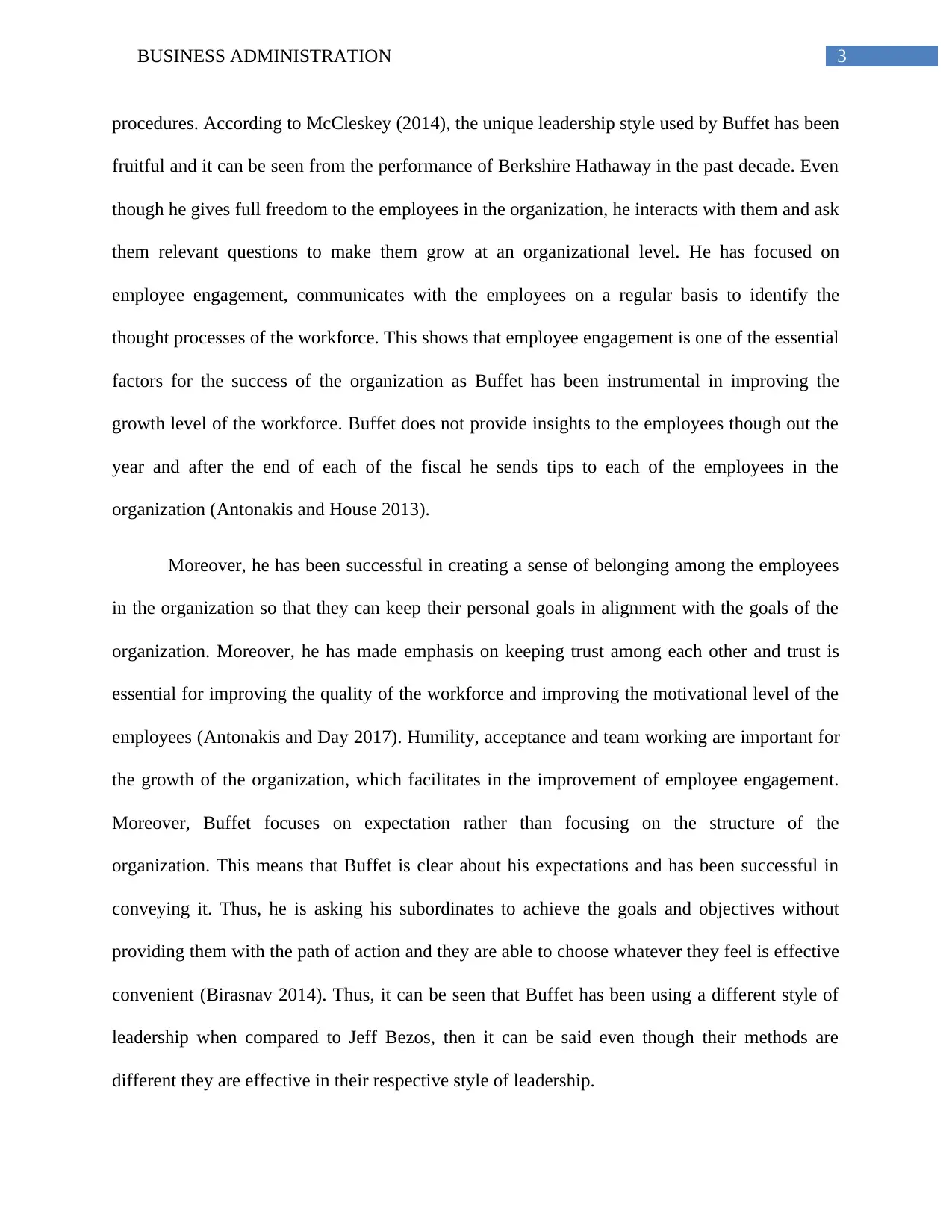
3BUSINESS ADMINISTRATION
procedures. According to McCleskey (2014), the unique leadership style used by Buffet has been
fruitful and it can be seen from the performance of Berkshire Hathaway in the past decade. Even
though he gives full freedom to the employees in the organization, he interacts with them and ask
them relevant questions to make them grow at an organizational level. He has focused on
employee engagement, communicates with the employees on a regular basis to identify the
thought processes of the workforce. This shows that employee engagement is one of the essential
factors for the success of the organization as Buffet has been instrumental in improving the
growth level of the workforce. Buffet does not provide insights to the employees though out the
year and after the end of each of the fiscal he sends tips to each of the employees in the
organization (Antonakis and House 2013).
Moreover, he has been successful in creating a sense of belonging among the employees
in the organization so that they can keep their personal goals in alignment with the goals of the
organization. Moreover, he has made emphasis on keeping trust among each other and trust is
essential for improving the quality of the workforce and improving the motivational level of the
employees (Antonakis and Day 2017). Humility, acceptance and team working are important for
the growth of the organization, which facilitates in the improvement of employee engagement.
Moreover, Buffet focuses on expectation rather than focusing on the structure of the
organization. This means that Buffet is clear about his expectations and has been successful in
conveying it. Thus, he is asking his subordinates to achieve the goals and objectives without
providing them with the path of action and they are able to choose whatever they feel is effective
convenient (Birasnav 2014). Thus, it can be seen that Buffet has been using a different style of
leadership when compared to Jeff Bezos, then it can be said even though their methods are
different they are effective in their respective style of leadership.
procedures. According to McCleskey (2014), the unique leadership style used by Buffet has been
fruitful and it can be seen from the performance of Berkshire Hathaway in the past decade. Even
though he gives full freedom to the employees in the organization, he interacts with them and ask
them relevant questions to make them grow at an organizational level. He has focused on
employee engagement, communicates with the employees on a regular basis to identify the
thought processes of the workforce. This shows that employee engagement is one of the essential
factors for the success of the organization as Buffet has been instrumental in improving the
growth level of the workforce. Buffet does not provide insights to the employees though out the
year and after the end of each of the fiscal he sends tips to each of the employees in the
organization (Antonakis and House 2013).
Moreover, he has been successful in creating a sense of belonging among the employees
in the organization so that they can keep their personal goals in alignment with the goals of the
organization. Moreover, he has made emphasis on keeping trust among each other and trust is
essential for improving the quality of the workforce and improving the motivational level of the
employees (Antonakis and Day 2017). Humility, acceptance and team working are important for
the growth of the organization, which facilitates in the improvement of employee engagement.
Moreover, Buffet focuses on expectation rather than focusing on the structure of the
organization. This means that Buffet is clear about his expectations and has been successful in
conveying it. Thus, he is asking his subordinates to achieve the goals and objectives without
providing them with the path of action and they are able to choose whatever they feel is effective
convenient (Birasnav 2014). Thus, it can be seen that Buffet has been using a different style of
leadership when compared to Jeff Bezos, then it can be said even though their methods are
different they are effective in their respective style of leadership.
Paraphrase This Document
Need a fresh take? Get an instant paraphrase of this document with our AI Paraphraser
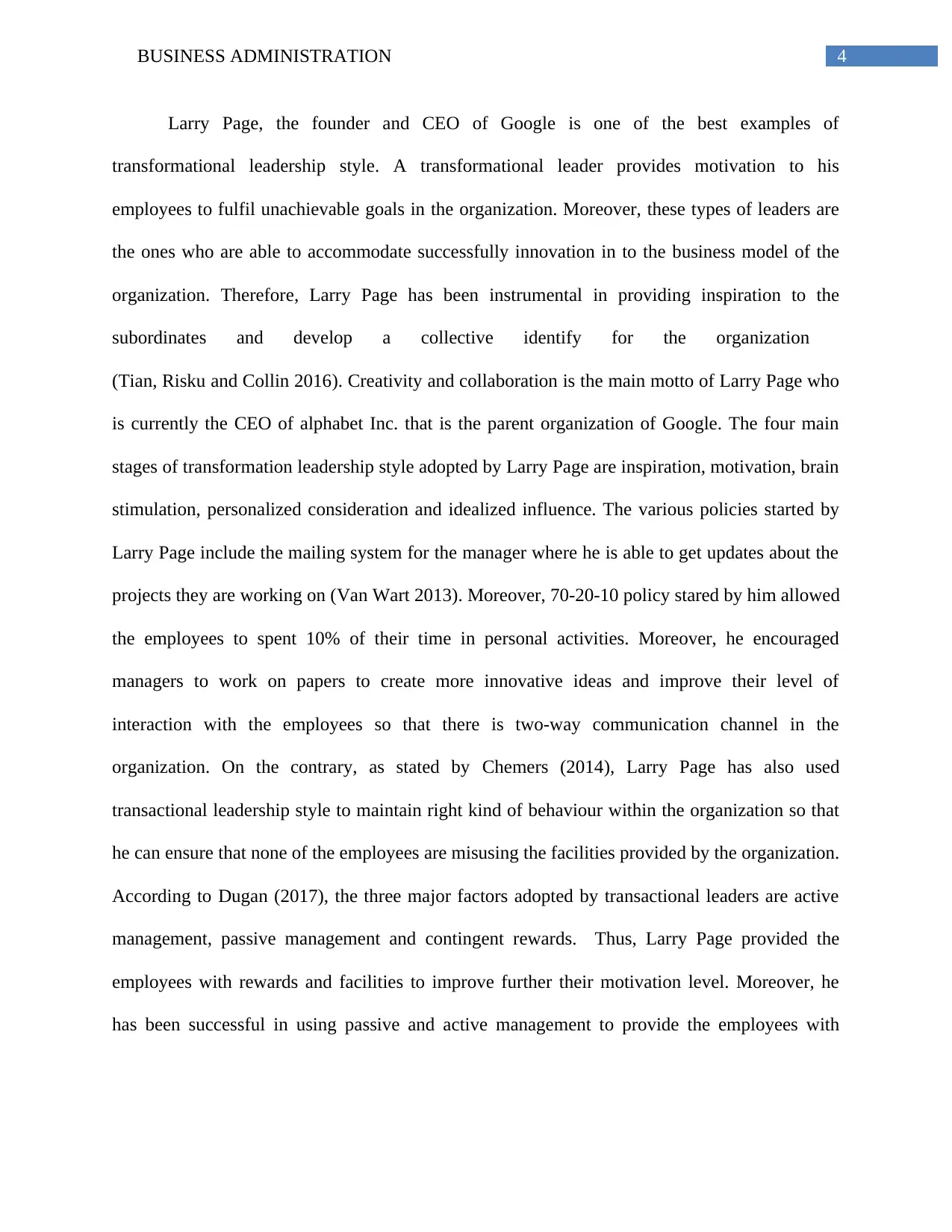
4BUSINESS ADMINISTRATION
Larry Page, the founder and CEO of Google is one of the best examples of
transformational leadership style. A transformational leader provides motivation to his
employees to fulfil unachievable goals in the organization. Moreover, these types of leaders are
the ones who are able to accommodate successfully innovation in to the business model of the
organization. Therefore, Larry Page has been instrumental in providing inspiration to the
subordinates and develop a collective identify for the organization
(Tian, Risku and Collin 2016). Creativity and collaboration is the main motto of Larry Page who
is currently the CEO of alphabet Inc. that is the parent organization of Google. The four main
stages of transformation leadership style adopted by Larry Page are inspiration, motivation, brain
stimulation, personalized consideration and idealized influence. The various policies started by
Larry Page include the mailing system for the manager where he is able to get updates about the
projects they are working on (Van Wart 2013). Moreover, 70-20-10 policy stared by him allowed
the employees to spent 10% of their time in personal activities. Moreover, he encouraged
managers to work on papers to create more innovative ideas and improve their level of
interaction with the employees so that there is two-way communication channel in the
organization. On the contrary, as stated by Chemers (2014), Larry Page has also used
transactional leadership style to maintain right kind of behaviour within the organization so that
he can ensure that none of the employees are misusing the facilities provided by the organization.
According to Dugan (2017), the three major factors adopted by transactional leaders are active
management, passive management and contingent rewards. Thus, Larry Page provided the
employees with rewards and facilities to improve further their motivation level. Moreover, he
has been successful in using passive and active management to provide the employees with
Larry Page, the founder and CEO of Google is one of the best examples of
transformational leadership style. A transformational leader provides motivation to his
employees to fulfil unachievable goals in the organization. Moreover, these types of leaders are
the ones who are able to accommodate successfully innovation in to the business model of the
organization. Therefore, Larry Page has been instrumental in providing inspiration to the
subordinates and develop a collective identify for the organization
(Tian, Risku and Collin 2016). Creativity and collaboration is the main motto of Larry Page who
is currently the CEO of alphabet Inc. that is the parent organization of Google. The four main
stages of transformation leadership style adopted by Larry Page are inspiration, motivation, brain
stimulation, personalized consideration and idealized influence. The various policies started by
Larry Page include the mailing system for the manager where he is able to get updates about the
projects they are working on (Van Wart 2013). Moreover, 70-20-10 policy stared by him allowed
the employees to spent 10% of their time in personal activities. Moreover, he encouraged
managers to work on papers to create more innovative ideas and improve their level of
interaction with the employees so that there is two-way communication channel in the
organization. On the contrary, as stated by Chemers (2014), Larry Page has also used
transactional leadership style to maintain right kind of behaviour within the organization so that
he can ensure that none of the employees are misusing the facilities provided by the organization.
According to Dugan (2017), the three major factors adopted by transactional leaders are active
management, passive management and contingent rewards. Thus, Larry Page provided the
employees with rewards and facilities to improve further their motivation level. Moreover, he
has been successful in using passive and active management to provide the employees with
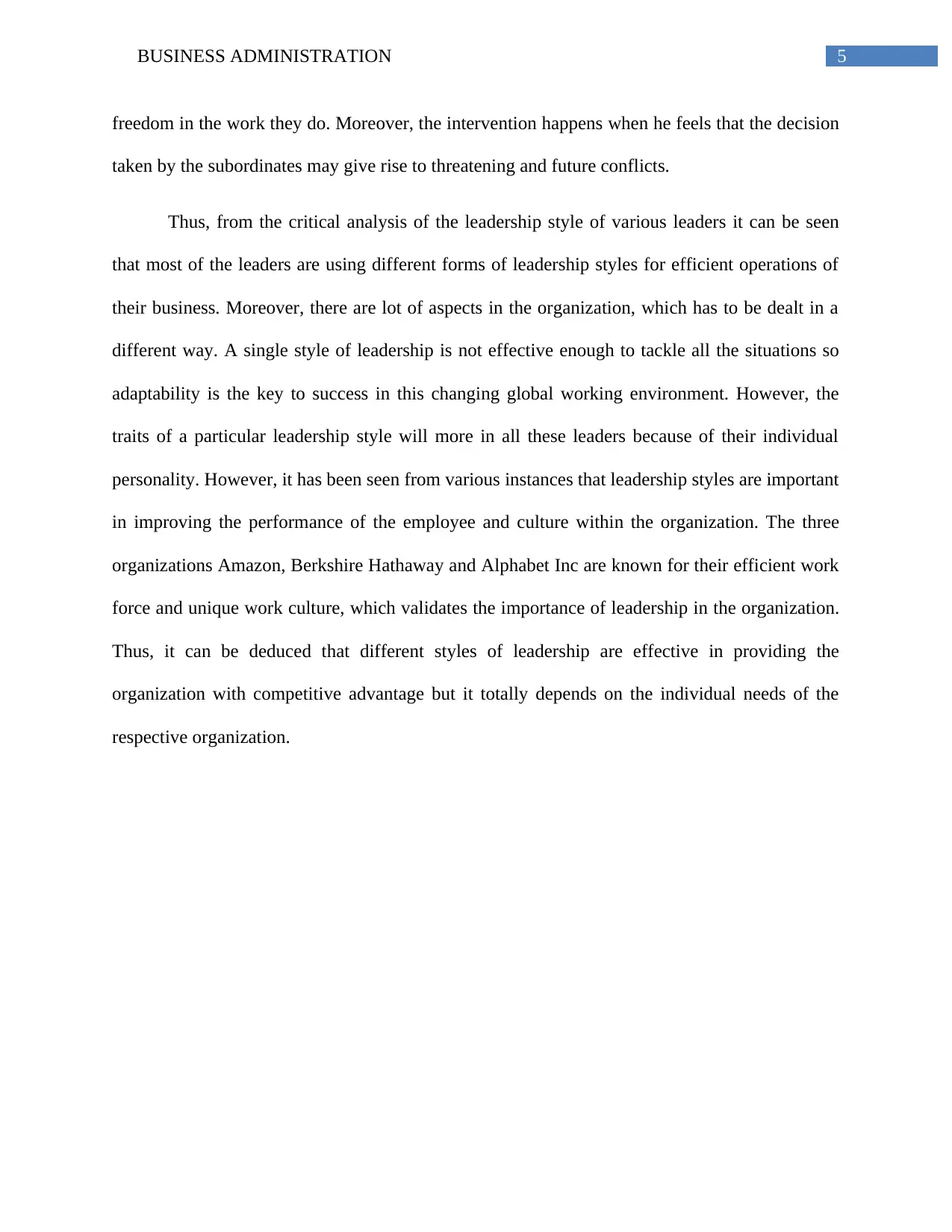
5BUSINESS ADMINISTRATION
freedom in the work they do. Moreover, the intervention happens when he feels that the decision
taken by the subordinates may give rise to threatening and future conflicts.
Thus, from the critical analysis of the leadership style of various leaders it can be seen
that most of the leaders are using different forms of leadership styles for efficient operations of
their business. Moreover, there are lot of aspects in the organization, which has to be dealt in a
different way. A single style of leadership is not effective enough to tackle all the situations so
adaptability is the key to success in this changing global working environment. However, the
traits of a particular leadership style will more in all these leaders because of their individual
personality. However, it has been seen from various instances that leadership styles are important
in improving the performance of the employee and culture within the organization. The three
organizations Amazon, Berkshire Hathaway and Alphabet Inc are known for their efficient work
force and unique work culture, which validates the importance of leadership in the organization.
Thus, it can be deduced that different styles of leadership are effective in providing the
organization with competitive advantage but it totally depends on the individual needs of the
respective organization.
freedom in the work they do. Moreover, the intervention happens when he feels that the decision
taken by the subordinates may give rise to threatening and future conflicts.
Thus, from the critical analysis of the leadership style of various leaders it can be seen
that most of the leaders are using different forms of leadership styles for efficient operations of
their business. Moreover, there are lot of aspects in the organization, which has to be dealt in a
different way. A single style of leadership is not effective enough to tackle all the situations so
adaptability is the key to success in this changing global working environment. However, the
traits of a particular leadership style will more in all these leaders because of their individual
personality. However, it has been seen from various instances that leadership styles are important
in improving the performance of the employee and culture within the organization. The three
organizations Amazon, Berkshire Hathaway and Alphabet Inc are known for their efficient work
force and unique work culture, which validates the importance of leadership in the organization.
Thus, it can be deduced that different styles of leadership are effective in providing the
organization with competitive advantage but it totally depends on the individual needs of the
respective organization.
⊘ This is a preview!⊘
Do you want full access?
Subscribe today to unlock all pages.

Trusted by 1+ million students worldwide
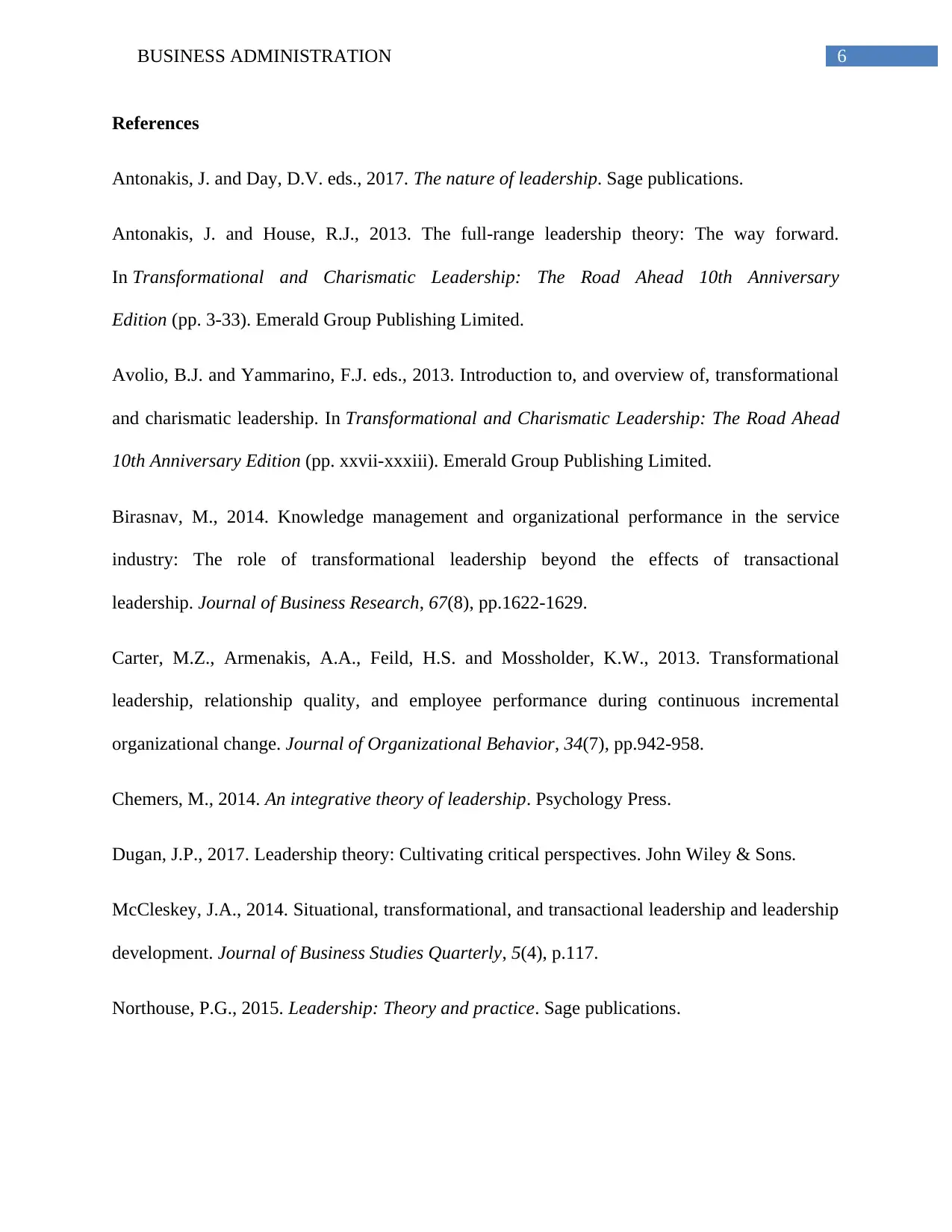
6BUSINESS ADMINISTRATION
References
Antonakis, J. and Day, D.V. eds., 2017. The nature of leadership. Sage publications.
Antonakis, J. and House, R.J., 2013. The full-range leadership theory: The way forward.
In Transformational and Charismatic Leadership: The Road Ahead 10th Anniversary
Edition (pp. 3-33). Emerald Group Publishing Limited.
Avolio, B.J. and Yammarino, F.J. eds., 2013. Introduction to, and overview of, transformational
and charismatic leadership. In Transformational and Charismatic Leadership: The Road Ahead
10th Anniversary Edition (pp. xxvii-xxxiii). Emerald Group Publishing Limited.
Birasnav, M., 2014. Knowledge management and organizational performance in the service
industry: The role of transformational leadership beyond the effects of transactional
leadership. Journal of Business Research, 67(8), pp.1622-1629.
Carter, M.Z., Armenakis, A.A., Feild, H.S. and Mossholder, K.W., 2013. Transformational
leadership, relationship quality, and employee performance during continuous incremental
organizational change. Journal of Organizational Behavior, 34(7), pp.942-958.
Chemers, M., 2014. An integrative theory of leadership. Psychology Press.
Dugan, J.P., 2017. Leadership theory: Cultivating critical perspectives. John Wiley & Sons.
McCleskey, J.A., 2014. Situational, transformational, and transactional leadership and leadership
development. Journal of Business Studies Quarterly, 5(4), p.117.
Northouse, P.G., 2015. Leadership: Theory and practice. Sage publications.
References
Antonakis, J. and Day, D.V. eds., 2017. The nature of leadership. Sage publications.
Antonakis, J. and House, R.J., 2013. The full-range leadership theory: The way forward.
In Transformational and Charismatic Leadership: The Road Ahead 10th Anniversary
Edition (pp. 3-33). Emerald Group Publishing Limited.
Avolio, B.J. and Yammarino, F.J. eds., 2013. Introduction to, and overview of, transformational
and charismatic leadership. In Transformational and Charismatic Leadership: The Road Ahead
10th Anniversary Edition (pp. xxvii-xxxiii). Emerald Group Publishing Limited.
Birasnav, M., 2014. Knowledge management and organizational performance in the service
industry: The role of transformational leadership beyond the effects of transactional
leadership. Journal of Business Research, 67(8), pp.1622-1629.
Carter, M.Z., Armenakis, A.A., Feild, H.S. and Mossholder, K.W., 2013. Transformational
leadership, relationship quality, and employee performance during continuous incremental
organizational change. Journal of Organizational Behavior, 34(7), pp.942-958.
Chemers, M., 2014. An integrative theory of leadership. Psychology Press.
Dugan, J.P., 2017. Leadership theory: Cultivating critical perspectives. John Wiley & Sons.
McCleskey, J.A., 2014. Situational, transformational, and transactional leadership and leadership
development. Journal of Business Studies Quarterly, 5(4), p.117.
Northouse, P.G., 2015. Leadership: Theory and practice. Sage publications.
Paraphrase This Document
Need a fresh take? Get an instant paraphrase of this document with our AI Paraphraser
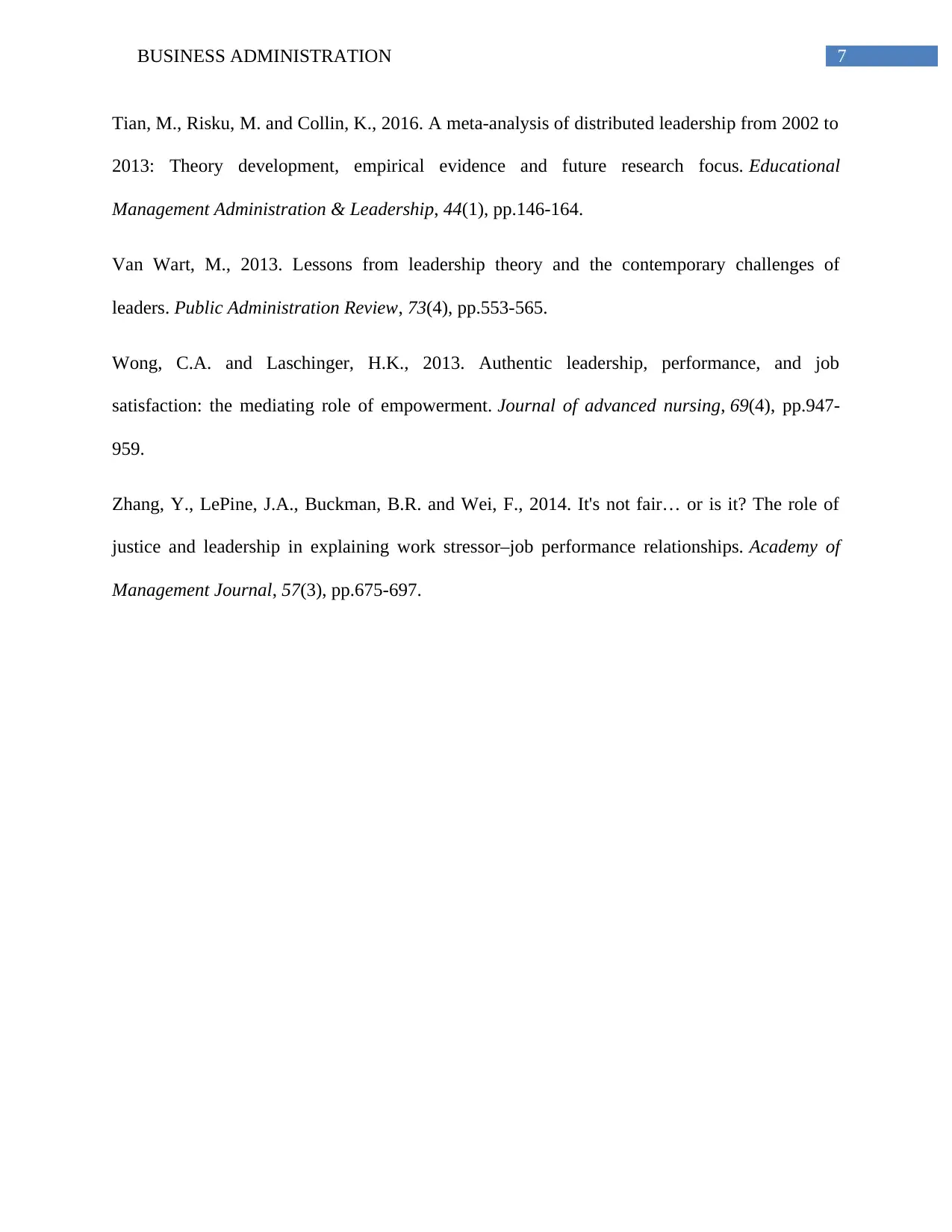
7BUSINESS ADMINISTRATION
Tian, M., Risku, M. and Collin, K., 2016. A meta-analysis of distributed leadership from 2002 to
2013: Theory development, empirical evidence and future research focus. Educational
Management Administration & Leadership, 44(1), pp.146-164.
Van Wart, M., 2013. Lessons from leadership theory and the contemporary challenges of
leaders. Public Administration Review, 73(4), pp.553-565.
Wong, C.A. and Laschinger, H.K., 2013. Authentic leadership, performance, and job
satisfaction: the mediating role of empowerment. Journal of advanced nursing, 69(4), pp.947-
959.
Zhang, Y., LePine, J.A., Buckman, B.R. and Wei, F., 2014. It's not fair… or is it? The role of
justice and leadership in explaining work stressor–job performance relationships. Academy of
Management Journal, 57(3), pp.675-697.
Tian, M., Risku, M. and Collin, K., 2016. A meta-analysis of distributed leadership from 2002 to
2013: Theory development, empirical evidence and future research focus. Educational
Management Administration & Leadership, 44(1), pp.146-164.
Van Wart, M., 2013. Lessons from leadership theory and the contemporary challenges of
leaders. Public Administration Review, 73(4), pp.553-565.
Wong, C.A. and Laschinger, H.K., 2013. Authentic leadership, performance, and job
satisfaction: the mediating role of empowerment. Journal of advanced nursing, 69(4), pp.947-
959.
Zhang, Y., LePine, J.A., Buckman, B.R. and Wei, F., 2014. It's not fair… or is it? The role of
justice and leadership in explaining work stressor–job performance relationships. Academy of
Management Journal, 57(3), pp.675-697.
1 out of 8
Related Documents
Your All-in-One AI-Powered Toolkit for Academic Success.
+13062052269
info@desklib.com
Available 24*7 on WhatsApp / Email
![[object Object]](/_next/static/media/star-bottom.7253800d.svg)
Unlock your academic potential
Copyright © 2020–2025 A2Z Services. All Rights Reserved. Developed and managed by ZUCOL.




